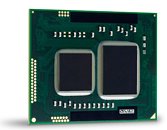- Joined
- Oct 9, 2007
- Messages
- 47,241 (7.55/day)
- Location
- Hyderabad, India
| System Name | RBMK-1000 |
|---|---|
| Processor | AMD Ryzen 7 5700G |
| Motherboard | ASUS ROG Strix B450-E Gaming |
| Cooling | DeepCool Gammax L240 V2 |
| Memory | 2x 8GB G.Skill Sniper X |
| Video Card(s) | Palit GeForce RTX 2080 SUPER GameRock |
| Storage | Western Digital Black NVMe 512GB |
| Display(s) | BenQ 1440p 60 Hz 27-inch |
| Case | Corsair Carbide 100R |
| Audio Device(s) | ASUS SupremeFX S1220A |
| Power Supply | Cooler Master MWE Gold 650W |
| Mouse | ASUS ROG Strix Impact |
| Keyboard | Gamdias Hermes E2 |
| Software | Windows 11 Pro |
Back in December, it was reported that Intel could license AMD's GPU technology for integration into its future processors. The whispers are growing louder, with Hard|OCP editor Kyle Bennett (who broke the original December story), reporting that the first product of this collaboration could be out within 2017. According to Bennett, posting on the Hard|OCP Forums, the first Intel product with AMD Radeon GPU IP could be a special processor with an AMD Radeon GPU die, and a CPU die based on the "Kaby Lake" micro-architecture.
Bennett further adds that the Radeon-enhanced Intel processor could be a multi-chip module (MCM) with the Radeon GPU die being separate from the CPU die, it won't be an on-die component such as Intel's own HD Graphics solution. This could also mean that AMD will supply nearly-finished dies to Intel, likely manufactured at its own trusted fabs (Global Foundries or TSMC), and not hand over sensitive designs over to Intel's fabs. The product could be an entry-mid range product, which means Intel is trying to aim for the value consumer segment, and not necessarily the workstation crowd. Bennett concludes that one could expect more collaboration between Intel and AMD over graphics IP in the future.

View at TechPowerUp Main Site
Bennett further adds that the Radeon-enhanced Intel processor could be a multi-chip module (MCM) with the Radeon GPU die being separate from the CPU die, it won't be an on-die component such as Intel's own HD Graphics solution. This could also mean that AMD will supply nearly-finished dies to Intel, likely manufactured at its own trusted fabs (Global Foundries or TSMC), and not hand over sensitive designs over to Intel's fabs. The product could be an entry-mid range product, which means Intel is trying to aim for the value consumer segment, and not necessarily the workstation crowd. Bennett concludes that one could expect more collaboration between Intel and AMD over graphics IP in the future.

View at TechPowerUp Main Site




